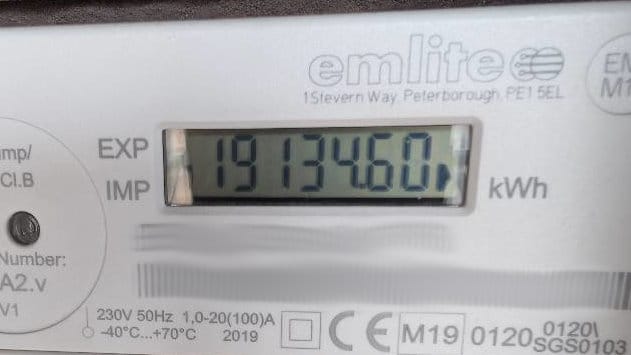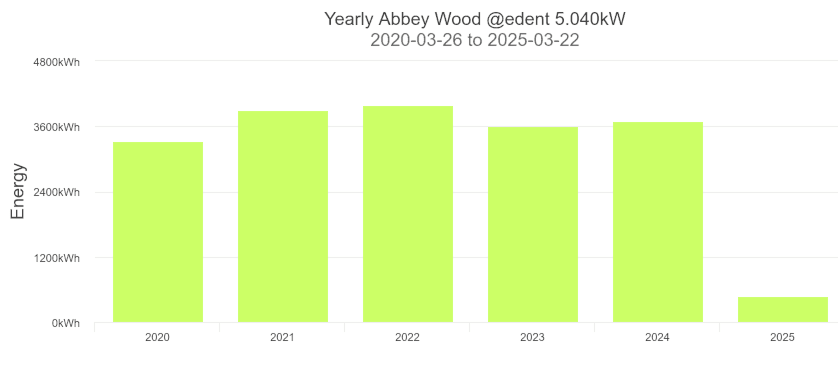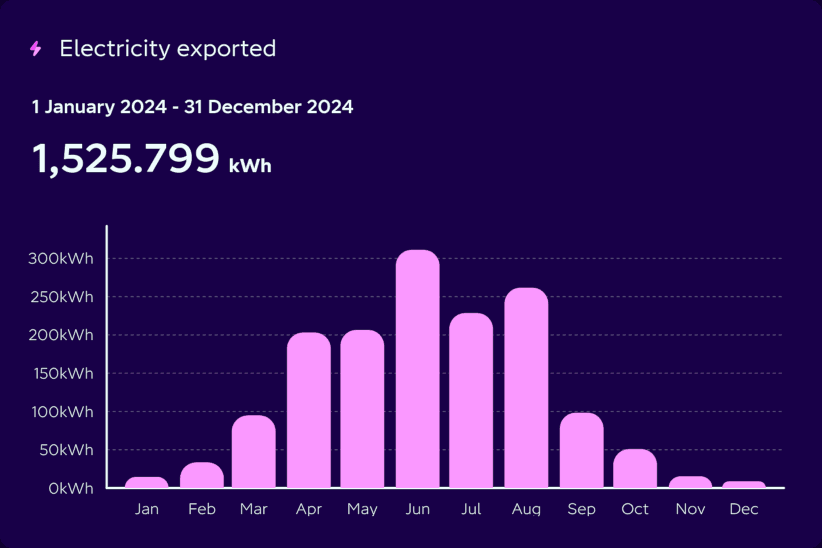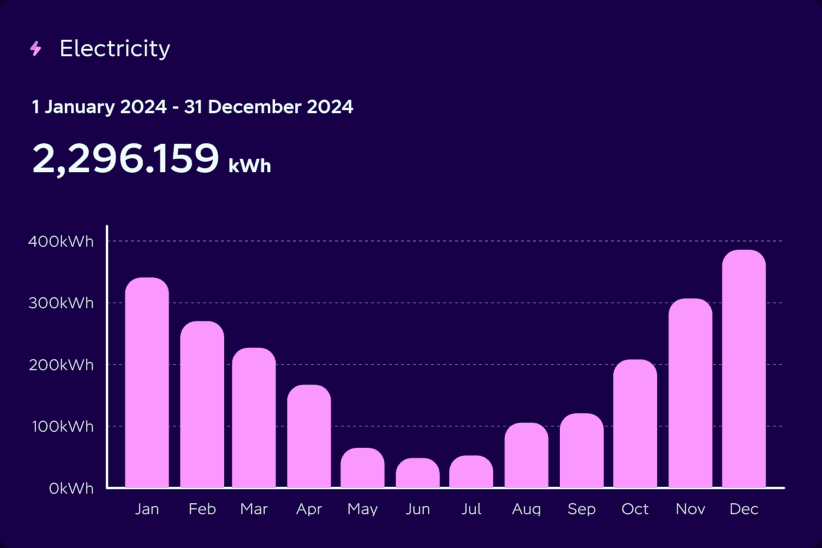Five years ago today, we installed solar panels on our house in London. Solar panels are the ultimate in "boring technology". They sit on the roof and generate electricity whenever the sun shines. That's it.
This morning, I took a reading from our generation meter:

19MWh of electricity stolen from the sun and pumped into our home.
That's an average of 3,800 kWh every year. But what does that actually mean?
The UK's Department for Energy Security and Net Zero publishes quarterly reports on energy prices. Its most recent report suggests that a typical domestic consumption is "3,600 kWh a year for electricity".
Ofgem, the energy regulator, has a more detailed consumption breakdown which broadly agrees with DESNZ.
On that basis, our solar panels are doing well! A typical home would generate slightly more than they use.
Net Zero
What is "Net Zero"?
Put simply, net zero refers to the balance between the amount of greenhouse gas (GHG) that's produced and the amount that's removed from the atmosphere. It can be achieved through a combination of emission reduction and emission removal. National Grid
I don't have the ability to remove carbon from the atmosphere0 so I have to focus on reducing my emissions1.
Numbers
All of our panels' generation stats are published online.
Let's take a look at 2024 - the last complete year:

Generation was 3,700 kWh - a little below average. Obviously a bit cloudy!
We try to use as much as we can when it is generated, and we store some electricity in our battery. But we also sell our surplus to the grid so our neighbours can benefit from greener energy.
Here's how much we exported last year, month by month:

Bit of a dip during the disappointing summer, but a total export of 1,500 kWh.
We used a total of (3,700 - 1,500) = 2,200 kWh of solar electricity.
Of course, the sun doesn't provide a lot of energy during winter, and our battery can't always cope with our demand. So we needed to buy electricity from the grid.

We imported 2,300 kWh over 2024.
Quick maths! Our total electricity consumption was 4,500 kWh during the year.
Very roughly, we imported 2,300 and exported 1,500. That means our "net" import was only 800kWh.
There's a slight wrinkle with the calculations though. Our battery is aware that we're on a a dynamic tariff; the price of electricity varies every 30 minutes. If there is surplus electricity (usually overnight) the prices drop and the battery fills up for later use.
In 2024, our battery imported about 990 kWh of cheap electricity (it also exported a negligible amount).
If our battery hadn't been slurping up cheap energy, we would be slightly in surplus; exporting 190 kWh more than we consumed.
So, I'm happy to report that our panels take us most of the way to a personal net zero for domestic electricity consumption.
A Conclusion (of sorts)
The fight against climate change can't be won by individuals. It is a systemic problem which requires wholesale change in politics, industry, and regulation.
But, as a society, we can all do our bit. Get solar panels, install a heat pump, buy more efficient appliances, walk or take public transport, switch to a more sustainable diet, learn about your impact on our world.
More importantly - tell other people what you're doing!
Speak to your friends and neighbours. Shout about being more environmentally conscious on social media. Talk to your local and national politicians - explain to them why climate change is a personal priority. Write in favour of solar and wind farms being installed near you. Don't be silent. Don't be complicit in the desecration of our planet.
Bonus referral link
The import and export data is available via Octopus Energy's excellent API. They also have smart tariffs suitable for people with solar and / or batteries. Join Octopus Energy today and we both get £50.
10 thoughts on “What does a "Personal Net Zero" look like?”
@Edent
👎 "electricity stolen from the sun"
👍 "energy bestowed upon our house by Helios"
| Reply to original comment on ohai.social
@Edent We generated a nice amount last year. With the EV it may not be enough to totally run the house, but it's saving us money. With our tariff we save most by exporting as much as possible as we can charge the battery off peak for less than Octopus pay us. If more people get batteries then the economics will change.
| Reply to original comment on mastodon.org.uk
James A
I'd previously written to quibble (with incorrect formatting) about this calculation:
...because I felt that the 800kWh later consumed by that battery would instead have been fulfilled by the grid. But after re-reading: I think that the idea is that it would instead have been subtracted from your exports -- and that makes sense (assuming that the battery had enough energy, without from-surplus charging, to meet the demand during those times).
In any case: nice to read about progress towards net zero energy at home.
not quite zero
How long does it take to buy down the emissions generated from manufacturing the panels and batteries?
@edent
Basically nothing. See https://energytheory.com/carbon-footprint-of-solar-panel-manufacturing/
You can also read the IEA's report at https://iea.blob.core.windows.net/assets/d2ee601d-6b1a-4cd2-a0e8-db02dc64332c/SpecialReportonSolarPVGlobalSupplyChains.pdf
(Your comment is classic "whatabouterry" - a futile attempt to derail a conversation by raising the suggestion of controversy.)
Merton
Excellent info, thanks. Small thought. My daughter lives in UK and use "smart meter" to recharge her EV at night when electricity is cheap. Very good idea. But, it di occur to me that the cheap electricity that is available during the night is not necessarily more green than the more expensive electricity available during the rest of the day. As I understand it, the cheap electricity available at night primarily comes from those sources that have long "spin-up" times, meaining (I think) that they need to be kept running at a pretty constant rate, they are not easy to vary their output. A little research done by a friend shows that these are, of course, nuclear and the big steam powered generating stations that mostly use fossil fuels for power. So, the nuclear is pretty green (I'm ignoring the nuclear waste and decommisioning costs/problems at end of life). But the steam powered are buring fossel fuels, not so green. I think it is great to have more people with solar panels, I am considering them myself. My big problems if collecting all the info necessary to make an informaed decision. I live in Belgium.
@edent
It depends. If you look at https://grid.iamkate.com/ you can see the UK's energy mix. Sometimes, the cheap overnight electricity is primarily wind.
I keep thinking about solar, as our electricity consumption is high, but we live in a tall, narrow, mid terrace with a nice false gable upsetting the roofline. I reckon we could get about five panels up there, if we can persuade anybody to go up that high. With the long repayment times, it feels like it'd be barely worth it.
@edent
We live in a tall, narrow, mid-terrace. We have panels on both sides of the roof. Any installer will be used to putting scaffolding up that high.
Even with our non-optimal aspect, our repayment time is low. And, of course, after that it is pure profit.
@Edent We're at 1.5MWh exported (of about 10MWh total) since 2022. In Scotland, where solar could never possibly work.
| Reply to original comment on mastodon.scot
More comments on Mastodon.